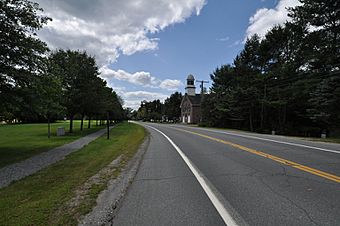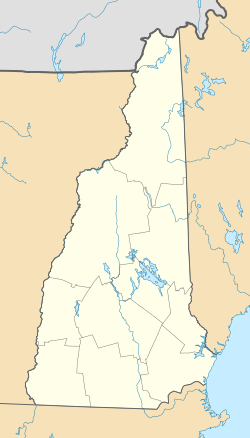Orford Street Historic District facts for kids
Quick facts for kids |
|
|
Orford Street Historic District
|
|

Promenade on the left, Masonic Hall in the distance on the right
|
|
| Location | Orford St. (NH 10) from Rt. 25A to Archertown Rd., E to include cemetery, Orford, New Hampshire |
|---|---|
| Area | 43.2 acres (17.5 ha) |
| Architect | Multiple |
| Architectural style | Greek Revival, Late Victorian, Federal |
| NRHP reference No. | 77000163 |
| Added to NRHP | August 26, 1977 |
The Orford Street Historic District is a super cool part of Orford, New Hampshire. It's a special street that people have loved for a long, long time. Imagine a beautiful road with lots of trees! This area was even called "the most charming country village" way back in the 1700s.
Contents
Discovering Orford Street's History
This historic district covers about half a mile of Orford Street. It runs between two other roads: New Hampshire Route 25A and Archertown Road. This special area was added to the National Register of Historic Places in 1977. This means it's recognized as an important place in history!
What Makes This Area Special?
One of the best things about Orford Street is its amazing tree-lined path. This path is called a promenade. It was first created around the year 1800. Today, it's a paved lane with big, old trees on both sides. This promenade is still a main part of the town center. It's a great place for a walk!
Old Buildings and Their Stories
On the west side of Orford Street, you'll find many old buildings. These buildings were built in the 1700s and 1800s. They include homes and important town buildings. Many of these houses are built in a style called Federal. They were constructed between 1773 and 1839 along an area known as The Ridge.
Famous Architects and Styles
Some of these Federal-style houses show the influence of a famous architect named Asher Benjamin. People believe he might have designed one of them! You can see different building styles here. Besides Federal, there's also Greek Revival and Late Victorian architecture.
Important Buildings to See
- Masonic Hall: This brick building was built in 1840. It used to be a church before it became the Masonic Hall.
- Orford Congregational Church: This church was built in 1850. It has a unique style called Gothic Revival.
- The Academy: Built in 1851, this was once a school.
- Old Commercial Building: Near the south end of the district, you'll find the only old shop building left. It's at the corner of Bridge Street.
The Town Cemetery
At the very north end of the district, just east of the promenade, is the town cemetery. This cemetery was started in 1773. The land for it was given by a person named Israel Morey. It's a quiet place with a lot of history.




